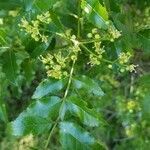Tall shrub or small tree; lfls 5–19, obliquely lanceolate to ovate, shallowly crenate, glabrous; fls numerous in large terminal cymes; sep present; ovaries 2 or 3; frs nearly sessile, subglobose, 5 mm, wrinkled or pitted; 2n=72. Damp woods; Delmarva Penins., on outer coastal plain to Fla., thence w. to Tex., Ark., and se. Okla. Apr., May.




